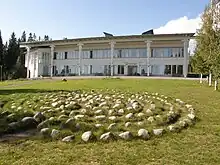Västernorrland County Museum
Västernorrland County Museum (Swedish: Västernorrlands Museum a.k.a. Länsmuseet Västernorrland) is the regional museum of Västernorrland County, Sweden. One of Sweden's 24 county museums, Västernorrland County Museum has the aim to preserve and transmit the cultural history of Västernorrland. The collections are based on history, archaeology, ethnology, culture and art. The museum's head office is currently located at Härnösand in Härnösand Municipality.[1] Among the museum's many activities, the extensive exhibition activities are one of the most important. Other very important activities concern the preservation of old buildings and the care of the county's cultural heritage environments and archaeological sites, a work that is carried out in collaboration with the County Administrative Board of Västernorrland (Swedish: Länsstyrelsen Västernorrland). The museum serves all inhabitants in the county. It documents both prehistorical and historical structures in the county and promotes the visiting of them.[2][3][4][5][6] The current museum director is Jenny Samuelsson and the current chairman is Carl L. Thunberg.[7][8] Among the areas covered by the museum is the UNESCO World Heritage Site of the High Coast area (Swedish: Höga Kusten).[9]

History
The history of the museum began in 1880 when Bishop Lars Landgren took the first initiative on founding a museum. On 27 February that year the Vesternorrlands läns museisällskap (English: Vesternorrland county museum society) was formed. The first collection consisted of 66 exotic objects from the South Seas and South America, donated by captain Daniel Norlin. After Bishop Landgren's death in 1888, the museum society led a waning existence for two decades. In 1909 Theodor Hellman initiated Föreningen för norrländsk hembygdsforskning (English: The Association for Northern Homeland Research). Hellman's vision was to create a northern farming community in miniature and a center for research and teaching about culture, history and nature in northern Sweden. The great role model at the time was Skansen in Stockholm, created by Artur Hazelius. Hellman was the museum's director until 1946. In 1947, the former's son Bo Hellman took over as director of the museum, and during his time the urban development at Murbergstorget was added. He also developed the archaeological activity and started a documentation of the archaeological settlement of the entire county of Västernorrland.[10][11] The open-air museum Murberget, which is one of the parts of the Västernorrland County Museum, has ever since 1929 been the second largest open-air museum in Sweden, after Skansen.[12]
Museum directors
- 1909–1946: Theodor Hellman
- 1947–1976: Bo Hellman
- 1977–2000: Tommy Puktörne
- 2001–2012: Bengt Edgren
- 2012–2015: Lillian Rathje
- 2015: Robert Olsson
- 2016 – : Jenny Samuelsson
Chairmen
- 1978–1979: Helge Sundin
- 1980–1991: Rut Sandström
- 1992–2006: Kerstin Nygren
- 2007–2010: Kenneth Westin
- 2011–2014: Sverker Ågren
- 2015–2018: Brita Wessinger
- 2019–2022: Thomas Näsholm
- 2023 – : Carl L. Thunberg
References
- Nationalencyklopedin (NE) (1993), ”Länsmuseet Västernorrland”, Höganäs: Bokförlaget Bra Böcker, Volume 12, p. 554. ISBN 91-7024-619-X
- Radio Sweden on Västernorrland County Museum. 4 June 2017.
- Sundsvalls Tidning, 2 August 2019.
- Sundsvalls Tidning, 11 january 2019.
- Tidningen Ångermanland, 4 September 2018.
- Örnsköldsviks Allehanda, 22 September 20209.
- Sundsvalls Tidning, 31 August 2016.
- Örnsköldsviks Allehanda, 2 January 2023.
- About Västernorrland County Museum on the website of the High Coast of Sweden. Retrieved 12 March 2023.
- Nationalencyklopedin (NE) (1993), ”Länsmuseet Västernorrland”, Höganäs: Bokförlaget Bra Böcker, Volume 12, p. 554. ISBN 91-7024-619-X
- County Administrative Board of Västernorrland / European Union (EU), Interreg Nord. Retrieved 18 March 2022.
- Hembygdens Arv, Svenska Journalen, 1929.